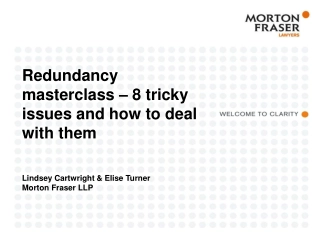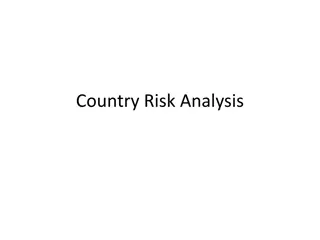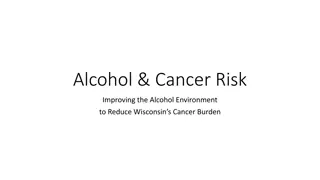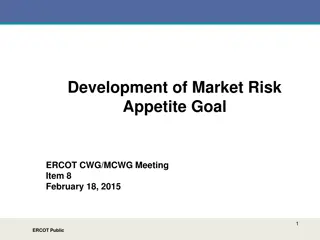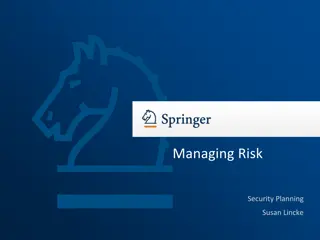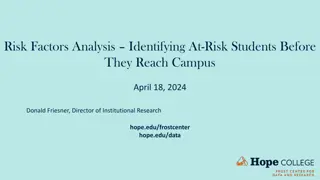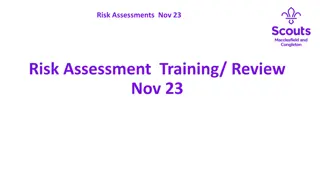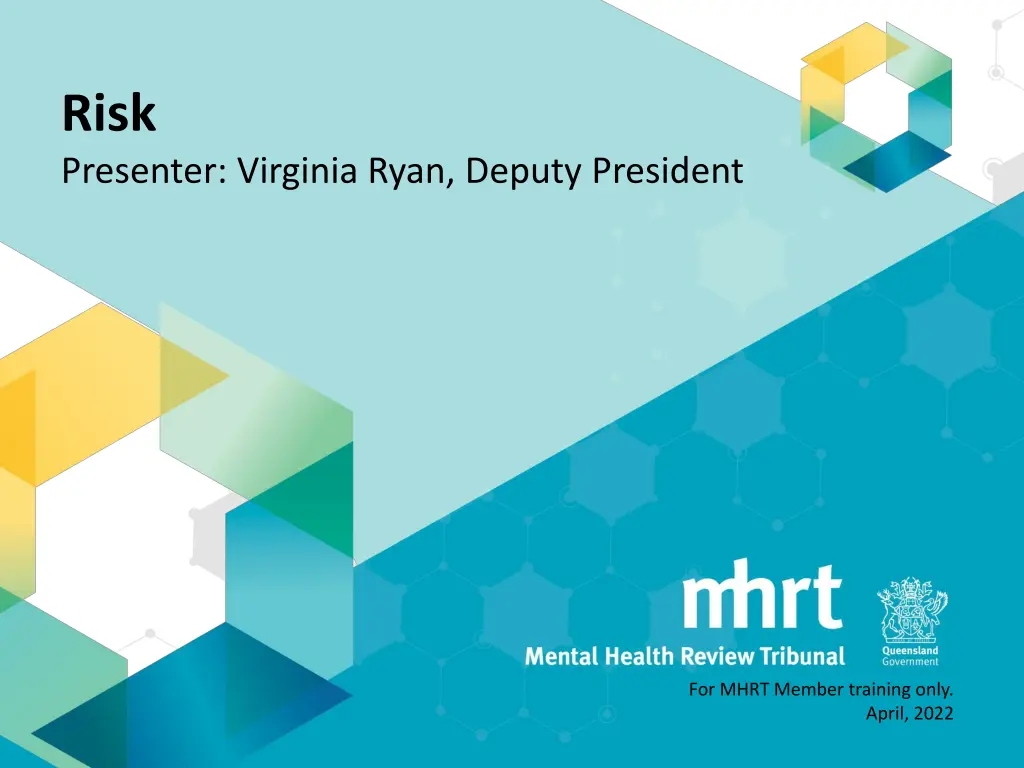
Understanding Risk Assessment and Management for Mental Health Professionals
Explore the essential aspects of risk assessment in mental health, including identifying different types of risks, evaluating risk factors, and understanding protective factors to mitigate harm. Gain insights into assessing risks to others, risks to self, and risks from external sources to enhance your knowledge and skills in managing mental health risks effectively.
Download Presentation

Please find below an Image/Link to download the presentation.
The content on the website is provided AS IS for your information and personal use only. It may not be sold, licensed, or shared on other websites without obtaining consent from the author. If you encounter any issues during the download, it is possible that the publisher has removed the file from their server.
You are allowed to download the files provided on this website for personal or commercial use, subject to the condition that they are used lawfully. All files are the property of their respective owners.
The content on the website is provided AS IS for your information and personal use only. It may not be sold, licensed, or shared on other websites without obtaining consent from the author.
E N D
Presentation Transcript
Risk Presenter: Virginia Ryan, Deputy President For MHRT Member training only. April, 2022
Topics What is risk and risk assessment? Identifying risk and levels of risk: which risks? who is at risk? from where does the risk arise? risk to physical vs mental health? Acceptable ris and obtaining evidence on risk. Red flags and additional considerations: illegal drug use? breach of conditions? Link between risk and capacity. Tribunal-ordered examination (TOE) reports. Risk mitigation. 2
Criteria in the MHA2016 Risk when reviewing an FO/TSO: to protect the safety of the community, including from the risk of serious harm to other persons or property. there is not an unacceptable risk to the safety of the community, because of the person s mental condition, including the risk of serious harm to other persons or property. When reviewing a TA: imminent serious harm to the person or others. Objects of the MHA2016: to protect the community if persons diverted from the criminal justice system may be at risk of harming others. The MHRT must determine a person s level of risk to decide whether it meets the criteria HOW DO WE DO THAT? 3
What is risk? Risk: the probability of an unwanted event that results in negative consequences. We could think of the level of risk as the product of two variables outcome (including seriousness of outcome) and likelihood. For the purposes of the MHA2016, the risk we are concerned with is the risk in the relevant test. 4
What do we mean by risk factors? Static/historic risk: Factors which do not change or change slowly. May provide baseline for long-term risk but may not accurately reflect current risk. E.g. past criminal offences, early maladjustment, history of substance use. Dynamic risk: Amenable to change, can fluctuate over time. May give a better prediction of imminent risk. E.g. active symptoms, treatment non-compliance, current drug use. 5
What are protective factors? Positive characteristics/circumstances that may make an individual more resilient to adverse events. May mitigate risk factors. E.g. good rapport with team, good social networks, stable accommodation. 6
Types of risk Risks to others: Violence (including physical, sexual, domestic). Other aggressive behaviour verbal aggression, threats. Reckless behaviour. Maltreatment of dependents. Property damage. Criminal offending e.g. stealing. Risks to self: Self-harm or suicide. Homelessness. Self-neglect. Misadventure. Risks from others: exploitation, abuse, neglect. 7
Risk assessment by the MHRT When we refer to risk assessment by MHRT members, we are not talking about the risk assessment that a clinician does. Clinical risk assessment: using standardised tools and clinical judgment for the purposes of assessing a patient and determining the course of treatment and care, including appropriate risk mitigation strategies. MHRT risk assessment: applying a legal test from the MHA2016 to the evidence presented (which may include clinical risk assessments) to make a decision under the MHA2016. 8
Conceptualising risk Risk assessment involves looking to the future and assessing the behaviour of concern, the potential damage or harm which may result from the behaviour and the probability it will happen. So you will likely need to receive evidence about: the specific risk factors. the imminence of those risks eventuating. the impact if those risks eventuated. Formulation of risk tries to tie all these things together. 9
Assessing risk Assessing risk: understanding and articulating the relationship between static and dynamic risk factors with consideration of: frequency severity patterns imminence consequences factors that increase risk protective factors identification of potential victims. 10
Future likelihood A 2018 study by the University of Manchester considered the use of risk assessment tools in UK mental health services. The focus was risks associated with suicide and self harm, but the key findings are generally relevant (The assessment of clinical risk in mental health services. National Confidential Inquiry into Suicide and Safety in Mental Health (NCISH). Manchester: The University of Manchester, 2018.) Some key findings: Risk assessment tools should not be seen as a way of predicting future suicidal behaviour. Risk is not a number, and risk assessment is not a checklist. The management of risk should be personal and individualised. 11
Which risks to consider Appeal MHC025: MHRT revoked the FO and made a TSO. AG appealed because the revocation of the FO was premature in all the circumstances. The AG argued on appeal that as the patient embarks on trying to re- connect with his children, an FO is necessary to minimise the risk to the community, particularly his former partner and her family. The MHC noted that the patient was legally represented in the family law matter and there was no evidence suggesting an increase in stress from those proceedings increased the risk to the community (including his former partner). The MHC noted the no contact order on the TSO, and the DVO under the Domestic and Family Violence Protect Act and that the steps taken by the patient in respect of the family law issues have been lawful. In dismissing the appeal, the MHC said to conflate the respondent s legal rights in his family law matter as a risk that requires a forensic order is a risk category beyond the scope of a forensic order. 12
Considering who is at risk Appeal MHC024: The MHRT had removed a condition from the person s FO which prevented contact with children under 16. The AG appealed. The MHC decided on the evidence the person presented with risk of general violence, deterioration of psychosis and violence associated with substance use. The MHC could not identify any specific risk to young people. The risk to children is no greater than the risk to other people in the community. The MHC agreed with the MHRT s decision to remove the condition. 13
Where does the risk come from? MHA2016 states because of the person s mental condition . So what if there is risk but it doesn t relate to the person s mental illness e.g. antisocial conduct, criminal disposition, drugs/alcohol. SWZ / Appeal MHC009: Aperson s existing mental condition is, of course, relevant in any review. But there is nothing in the wording of s442(1) which makes the current existence of a mental condition a prerequisite to the Tribunal exercising its power to confirm a forensic order. There is no threshold requirement in the MHA2016 that a person must have a current mental illness in order for the Tribunal to undertake a review of a forensic order. Aperson scurrent existing mentalcondition , while an important consideration, is but one of a number of matters which must be considered by the Tribunal in applying the test. 14
Compare SWZ to Appeal to MHC020 Appeal MHC020 concerned the question whether a person ever had a mental illness. The MHC concluded I could not be satisfied that he had a mental condition at the time of the index offences. The MHC revoked the person s FO and made no other order. Note: MHC said this is a very peculiar case and the circumstances of this case cannot be readily applied to other cases. 15
Risks regarding physical health Appeal MHC006. MHRT revoked an FO and made a TSO. AG appealed. The AG submitted it was inconsistent for the patient to refuse medical advice and treatment for his physical ailments, believing that God would look after him, yet the treating team considered that he engaged with them well and willingly took his medication. The MHC noted: It is a fact that [patient] does engage with his treating team and does comply with taking his medication. There may be reasons for why he does not seek to have treated a serious physical ailment, as explained by [doctor], he may make this choice either on a delusional basis or on a religious basis. The MHC found: In any event, the fact that he is not looking after himself physically does not constitute an appropriate reason for the Tribunal to have exercised its discretion in any other way than the way it did. 16
Levels of risk If you see a risk rating in a clinical report (e.g. high), you may wish to ask the team how they arrived at that level of risk. Levels are not fixed. Involves weighing evidence, balancing factors and predicting future state. Protective factors Risk Once risk level identified/considered: how stable is it? A rating is only a snapshot in time. what factors may increase or decrease it? is the risk conditional on something happening or not happening? what are the barriers to mitigating the risk, if any? 17
Level of risk The level of risk is an important consideration when determining whether an FO can be revoked and a TSO made. Deciding whether the risk is sufficiently low for a TSO can be difficult. Refer to MHRT s September 2021 masterclass on FO vs TSO. Refer to deidentified appeals on MHRT members website for decisions regarding FO vs TSO. 18
What is acceptable risk? Appeal MHC024: MHC accepted QHRC s submission. the question is not whether there is no risk because there is always some risk but whether the risk is unacceptable. The overall effect of the multiplicity of considerations in the individual facts and circumstances of the case must be considered, there must be sufficient likelihood of the occurrence of the risk in combination with the magnitude of harm if the risk eventuates and any other relevant circumstances which make the risk unacceptable. Consequently, even a relatively high risk of reoffending may be reduced to a risk that is not unacceptable when other circumstances (for example, the extent of the limit and strength of the case brought) are considered. 19
Clinician view vs MHRT view Clinicians and MHRT need to comply with the MHA2016, but have different perspectives. Treating teams provide evidence and clinical opinion to the MHRT. MHRT then needs to take that evidence and apply the tests/criteria in the MHA2016. Let s look at some examples. Thank you to Dr Geoff Leong, Medical Member for the following content. 20
Clinicians and MHRT may assess risk differently Patient does not attend appointments: Clinician s thinking: Are this missing medical appointments or case management? The patient is non-compliant. Will it lead to relapse? They may have a longer period unwell. May mean a tardy recovery. Need to keep the patient in treatment. The TA/FO is therefore still required. Member s thinking: The patient is non-compliant. Likelihood of relapse elevates. Risk of harm to self/others elevates. Imminent serious harm of self/others informs s12 (TA) OR need to protect the safety of the community informs s442 (FO). TA/FO is justified. Same outcome but different ways of getting there. 21
Consider this scenario Patient is on an FO. Diagnosed with schizophrenia. Stable for 5 years. Index offences: possession of a knife and wilful damage. Patient appeared unexpectedly at the office of his lawyer with a knife. Broke a window of his ex-wife s house by throwing a brick. Offending was a long time ago. No episodes of aggression since. Declines psychotherapy and NGO support. Case manager reports no active interventions, limited clinical engagement. Medical reviews occur every 2 months and patient is guarded when seen. 22
Clinician may focus on Patient is on an FO. Diagnosed with schizophrenia. Stable for 5 years. Index offences: possession of a knife and wilful damage. Patient appeared unexpectedly at the office of his lawyer with a knife. Broke a window of his ex-wife s house by throwing a brick. Offending was a long time ago. No episodes of aggression since. Declines psychotherapy and NGO support. Case manager reports no active interventions, limited clinical engagement. Medical reviews occur every 2 months and patient is guarded when seen. 23
Clinician may conclude Patient is doing ok alone. The FO does not really offer more support. Propose ceasing the FO. TSO could do the job . 24
MHRT may focus on Patient is on an FO. Diagnosed with schizophrenia. Stable for 5 years. Index offences: possession of a knife and wilful damage. Patient appeared unexpectedly at the office of his lawyer with a knife. Broke a window of his ex-wife s house by throwing a brick. Offending was a long time ago. No episodes of aggression since. Declines psychotherapy and NGO support. Case manager reports no active interventions, limited clinical engagement. Medical reviews occur every 2 months and patient is guarded when seen. 25
MHRT may conclude Remains guarded. No treatment = no risk mitigation. Risks remain. Community protection needed. Meets the test for s442. FO must be confirmed. 26
Evidence The MHRT needs evidence to be able to consider risk: Written and oral evidence. From all parties and witnesses. What weight you will give the evidence depends on a range of factors: currency, consistency, reliability, source. Appeal MHC001: it must reach a stage where due regard is given to the unanimous opinion of the treating psychiatrists and the treating team that the time has now been reached that the forensic order should be downgraded to a treatment support order. 27
Balancing risk Risk consideration probability of the risk eventuating (vertical) and the impact if it did (horizontal). assessment requires both a of the This matrix is general only and is intended to assist members to conceptually categories. identify risk These levels and ratings are examples only these may change depending on the circumstances for any particular individual. 28
Risk related to illegal drugs If a patient continues to use illegal drugs (e.g. cannabis), is this evidence of risk? What does it say about the patient s willingness to engage in activity even though they know it is illegal. What impact does the use of illegal drugs have on the patient s mental state/symptoms of illness? What impact does the use of illegal drugs have on the risk factors or protective factors identified? 29
Use of illegal drugs Appeal MHC024/GLH: MHRT revoked FO and made a TSO. Appeal by AG. The AG said as there was evidence the patient continued to use substances and so he should not have unsupervised contact with children. The QHRC submitted the main issue was to assess unacceptable risk. The MHC accepted there was no evidence of concerning behaviour, despite the continued drug use. The MHC did not accept that drug use automatically represented an unacceptable risk. It was necessary to weigh up all the relevant risk factors and protective factors and determine if it represented an unacceptable risk. 30
Breach of conditions Often an FO will have a condition not to use illegal drugs. Appeal MHC024/GLH shows drug use itself and the associated breach of condition, it not alone sufficient to constitute unacceptable risk. Consider: frequency and extent of breach. circumstances surrounding breach. the consequences of the breach on the level of risk. if it increases risk, does it result in unacceptable risk. 31
Breach of conditions Consider the following: The condition provides that the patient must not visit a particular suburb on the basis that the victim lives in the area and fears the patient. The patient has been seen by his case manager in the named suburb. At first the patient denied being in the suburb but later confirmed they were in that suburb but could not provide a good reason why. Consider the following: The condition provides that the patient must not drink alcohol. The condition was originally included because, while not intoxicated for the purposes of the MHC s considerations, the patient did frequently overuse alcohol at the time of the index offence. The patient reveals in a hearing that he occasionally has a few drinks when out with friends in a social setting. The treating psychiatrist was not aware of this but doesn t seem overly concerned. 32
Additional considerations Comorbidities the presence of one or more additional conditions co- occurring with the primary condition. Can create a more complex risk profile or change the magnitude or likelihood of certain risks. E.g. intellectual disability, personality disorders, physical health conditions. High risk symptoms may represent an increased risk profile. Command hallucinations, persecutory misidentification. Problem behaviours if these behaviours are noted in a clinical report, you may wish to ask if these have been individually risk assessed. E.g. Stalking, sexual offending, fire-setting, threats (fixated on people), antisocial behaviours. delusions, delusional 33
Capacity and risk The test to confirm an FO/TSO is related to risk the person can have capacity to consent to treatment and still be on an FO/TSO. Does this mean capacity is not relevant in a review of an FO/TSO? If a person does not have capacity to consent to treatment for their illness, what might this say about their risk? 34
Insight Insight and capacity are not necessarily the same. Insight involves multiple components: acceptance of illness. recognition of symptoms associated with illness and their cause response to recommended treatments. Lack of insight may suggest a lack of decision-making capacity but it will rarely be determinative. May need to query how the person s level of insight impacts on risk. E.g. Will it mean that the patient is less likely to take their medication ceasing medication leads to deterioration of mental state increasing risk. 35
Tribunal-ordered examination (TOE) reports The members may decide that they need additional information as to risk nature of risk, likelihood of risk, whether risk can be mitigated. May want an independent opinion. Can order a TOE report (s721). Order must state the matters (can be as questions) on which the practitioner must report. 36
Considerations before ordering a TOE Obtaining a TOE report can be costly and lengthy. It is a future panel that will receive and consider the report. Do you need a TOE report or do you have sufficient evidence on which to make your decision? (NB: TOE report required before revoking an FO for a prescribed offence) Give careful consideration to the questions you will ask of the practitioner. Consider asking for a broad/comprehensive risk assessment to give the practitioner flexibility to report on their opinion as to risk. Also ask specific questions to address gaps in the existing evidence: E.g. What is [the patient s] level of insight into the link between illness stability and medication? 37
Risk management The MHRT should receive evidence on strategies in place to manage any identified risk. These strategies may reduce risk to an acceptable level. Risk mitigation will involve strategies to reduce dynamic risk factors and increase protective factors. It is not the MHRT s role to identify the appropriate risk mitigation strategies and require them of the treating team. However, MHRT may make conditions on an authority or order which are aimed at reducing risk. 38
Conditions for risk mitigation Anything which impacts on full access to the community (i.e. community category with no conditions) constitutes a restriction. Effectively conditions refer back to category. Is a condition required in order to be able to expand community access? Eg: Is there a not unacceptable risk in making the category community? No, there is an unacceptable risk, I cannot make the category community because the potential for substance use means risk is unacceptable. Can I use the powers under s477 and make conditions to limit the parameters of the community access to reduce the risk to a not unacceptable level? Yes, I can add a condition requiring abstinence and testing for substances. 39

